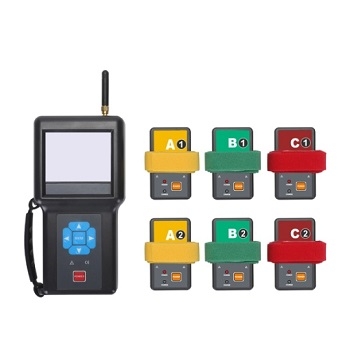Phase Testers, also known as Phase Sequence Testers or Phase Rotation Testers, are electrical testing devices used to determine the phase sequence (order) and phase rotation (direction) of the voltage in a three-phase electrical system. Phase rotation and sequence are critical factors in ensuring the proper and safe operation of motors, machinery, and electrical equipment in three-phase systems.
Operating Principle
The working principle of Phase Testers, specifically those used for phase sequence and phase rotation testing in three-phase electrical systems, is based on the detection of the relative phase angles and sequence of the three alternating current (AC) voltages or currents in the system. These testers are designed to provide a simple and reliable means of determining the phase sequence and rotation direction of the electrical supply. Here's how they work:
- Sensing the AC Voltages or Currents: Phase testers are equipped with sensors (typically voltage or current transformers) that are placed in close proximity to the conductors carrying the AC power. These sensors pick up the AC signal from the three phases.
- Comparison of Phases: The tester compares the phase angles of the three AC signals to determine their relative positions. In a correctly connected system, the three phases will be 120 degrees apart, forming a balanced and symmetrical electrical waveform.
- Indicator or Display: Phase testers usually have an indicator, such as a set of LED lights, a digital display, or a simple mechanical dial, to provide a visual indication of the phase sequence and rotation direction. The specific indicator pattern or reading varies depending on the tester's design.
- Phase Sequence Indication: Based on the comparison of the phase angles, the Phase Tester will indicate the correct phase sequence, which can be labeled as ABC (clockwise), BAC (counterclockwise), or some other notation, depending on the tester's conventions.
- Direction of Rotation: Some phase testers also indicate the direction of rotation (clockwise or counterclockwise) to help users understand the rotational direction of motors or machinery powered by the three-phase supply.

Key Functions and Applications
- Phase Sequence Detection: Phase testers determine the correct sequence in which the phases (L1, L2, and L3) are connected in a three-phase system. The phase sequence is typically indicated as ABC or clockwise, BAC or counterclockwise, or some similar notation, depending on the tester.
- Phase Rotation Determination: Phase rotation refers to the direction in which a motor or other rotating equipment rotates. Knowing the correct phase rotation is essential to ensure that motors and machinery operate in the intended direction. Incorrect phase rotation can lead to equipment damage and safety hazards.
- Safety and Preventing Damage: Correct phase sequence and rotation are crucial for safety. Incorrect phase connections can result in reverse motor rotation, leading to mechanical stress on equipment, reduced efficiency, and even equipment failure. Phase Testers help prevent such issues.
- Troubleshooting: Phase testers are invaluable for troubleshooting issues in electrical systems. If there are problems with motor operation or equipment malfunctions, verifying phase sequence and rotation can help identify potential causes.
- Commissioning: During the installation and commissioning of electrical systems, Phase Testers are used to ensure that all phases are correctly connected and that the equipment operates as intended.
Precautions
These testers are widely used by electricians, electrical engineers, and technicians working with three-phase electrical systems in industrial, commercial, and residential settings. Correct phase sequence and rotation are essential for the safe and efficient operation of electrical equipment, making Phase Testers an essential tool for electrical professionals.
- Safety Gear: Always wear appropriate personal protective equipment (PPE), including safety glasses, insulated gloves, and, if necessary, a flame-resistant suit when working with electrical systems.
- Turn Off Power: Ensure that the power to the electrical system or equipment being tested is switched off and locked out/tagged out to prevent accidental energization. Verify that there is no voltage present using a voltage detector or multimeter before beginning your tests.
- Inspect the Tester: Before each use, inspect the Phase Tester for any visible damage, wear, or exposed wires. Ensure that it is in good working condition.
- Test Leads and Probes: Use high-quality, properly insulated test leads and probes. Ensure that they are in good condition and securely connected to the tester and the test points.
- Secure Connections: Make sure that the tester's leads or sensors are securely and correctly connected to the electrical system's conductors or terminals.
- Avoid Touching Live Conductors: Do not touch live conductors with your hands or body. Always use insulated tools and wear insulated gloves when making connections.
- Work in a Dry Environment: Perform testing in a dry and well-ventilated environment. Avoid using Phase Testers in wet or damp conditions to prevent the risk of electrical shock.
It's important to use the right phase tester for the specific task at hand, as using the wrong type of tester can lead to inaccurate results and potentially unsafe working conditions. Additionally, always follow safety precautions and guidelines when working with electricity to prevent accidents and ensure personal safety. sisco.com offers high-quality phase testers, click to shop if you are interested.

